Singapore Impressions – Going Once, Going Twice
In 2019, my travel friend Kathy and I built a DIY trip to Asia, starting in Shanghai and including Singapore, a multicultural city with an interesting history, clean to the point chewing gum was regulated, and home to the famous Marina Bay Sands Resort, with its unique architecture and rooftop infinity pool, and to Changi airport with its indoor waterfall.
We arrived with plans; I also arrived with a lung infection (not Covid) that I’d picked up somewhere between home, Shanghai, Hong Kong, and Singapore. Luckily, I was flat out only the last day and wound up in a clinic at our next stop, Cambodia, where everyone was capable and kind. But that’s another story. This did slow down both of us in Singapore, though.
In any case, with only about three days to explore Singapore and with me incapacitated for a day, we left town with things yet to do, and planned to meet up there again, which we did in early 2024.
As with other big places I visit, this isn’t a travel guide, but it’s my story about some of the things that enriched those days in Singapore. The rest can be filled in easily with guidebooks and online research.
A Five-Sentence History for a Starter
The island of Singapore has been a trading outpost for millennia. Perhaps what we think of as “modern” Singapore dates from 1819 when the British arrived, and Sir Stamford Raffles established a trading post for the British East India Company. Trade boomed especially after the Suez Canal opened. After World War II and Japanese occupation, Singapore was first British again, then became part of the new Federation of Malaysia in 1963, and in 1965 seceded from Malaysia, becoming the independent city-state that we know today. It has long been a multicultural society, with four official languages, Malay, Mandarin, Tamil and English, and most citizens are at least bilingual.
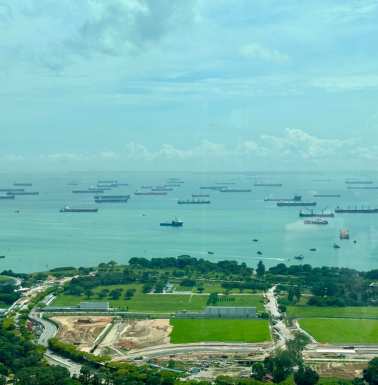
Traffic congestion also happens in the waterways with trade ships.
More Fives: The Five-Footway – Shelter from the Elements
This is a short digression because we found the footways a great relief from end-of-monsoon rains in 2024. Stamford Raffles’s town plan included the footways, created by requiring street-level shophouses to be set back five (or so) feet from the street, with upstairs living quarters extending out as far as the curb. This went for public buildings as well, and created a type of “veranda,” originally intended to protect pedestrians from the tropical sun, a sudden downpour, and the dangers of the street. As you would expect, the verandas soon filled with vendors, food hawkers and assorted others, making the footways sometimes chaotic and unsanitary, a long-lasting, contentious issue. There’s a good article on the Biblioasia website (“Give Me Shelter: The Five-footway Story,” Oct-Dec 2019). Around Tiong Bahru where we stayed there are five-footways and modern covered sidewalks, so we were able to shop, visit cafes, and reach the metro nearly entirely under shelter.
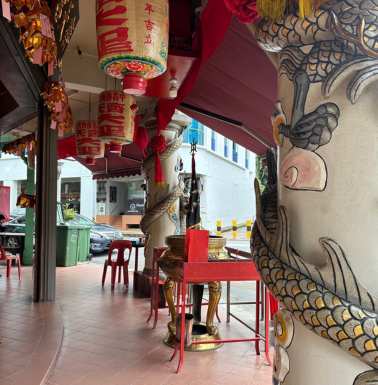
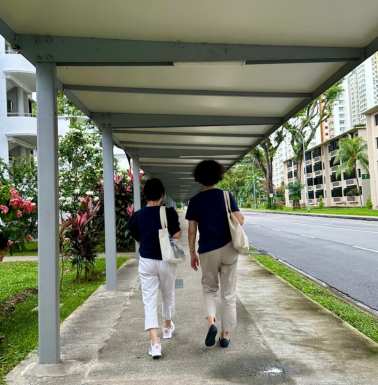
You can imagine that all those food vendors in the footways became a health hazard. So, the famously clean government of the newly independent Singapore began a program of licensing and regulation, resulting in development of safe, hygienic markets and hawker centers. The hawker culture is a huge part of Singaporean life, and I have more about it in Singapore Impressions – Tiong Bahru and its Hawker Culture.
Ethnic Neighborhoods
Stamford Raffles had clear ideas about developing a prosperous settlement that he had gleaned from experience in British and European colonies in Asia (Java, for example), emphasizing communal harmony and ease of trade. In his vision, that town plan would allocate land to each segment of society: government, Europeans and merchants, Chinese, Malays, and Indians. These fundamental divisions exist today, and visiting each neighborhood to see its temples, parks, markets, and businesses is probably on most first-timers’ agendas.
Our Visits – Zipping Around; a Non-Chronological Account
Before I continue with my favorites, here is an overview of our days in Singapore.
We got around on foot and by metro. Singapore has a well-developed underground, clean, fast and extensive. We bought transit cards from dispensers, like in Washington, DC, Paris, and other cities. Easy.
The first day in Singapore, back in 2019, we began with a visit to the Singapore Botanic Gardens. The gardens date from 1859 and if you like gardens, Kew Gardens near London, for example, this garden is well worth visiting. It’s the only tropical botanic garden on the UNESCO World Heritage list, and one of only three listed gardens (with Kew that I’ve mentioned, and the Orto Botanico di Padova, Italia, where I’ve also been). Do not confuse the Singapore Botanic Gardens with the Gardens by the Bay!
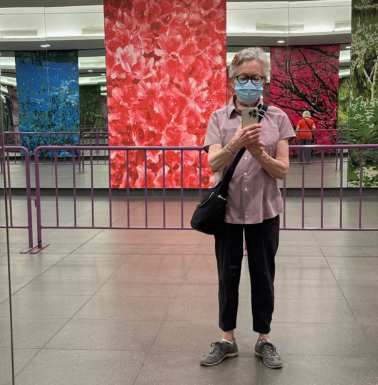
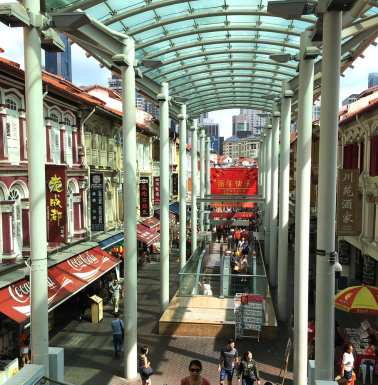


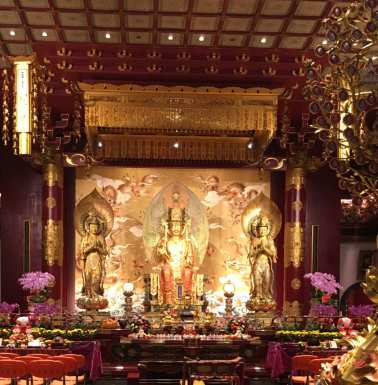

The next couple of days we saw the city in a hurry, zipping around by metro to Little India, with its temples and shops; Chinatown, where we saw the Buddha Tooth Relic Temple; and Kampong Gelam (the Muslim quarter), where you can follow the Heritage Trail and meet a true diversity of cultures. And I can’t neglect our stop at the Raffles Hotel Long Bar. We intended to wind up the 2019 trip by seeing the Gardens by the Bay, but my illness got the better of me at the Gardens, and I had to retreat to the hotel by taxi. The Gardens visit finally happened in 2024.
When we met up in 2024, the plan included Gardens by the Bay, another stop at the Long Bar, some historic buildings in the government sector, and a sweep through places of interest we couldn’t include in 2019.
The Raffles Hotel Long Bar – Home of the Singapore Sling
The Raffles Hotel Long Bar is where bartender Ngiam Tong Boon created the Singapore Sling in 1915. The cocktail is primarily gin-based and loaded with fruit juices, specifically to give ladies a sly way to drink alcohol in public, something that was forbidden at the time.
The Long Bar is a popular tourist stop, but in 2019, it was a delightful respite from sightseeing. Raffles Hotel (as in Sir Stamford) is emblematic, and in 2019 was under renovation which meant no guests. And it being before the lockdown, the tourist pressure wasn’t as great, either. We were seated quickly in the 1920s Malayan-style bar, presented with shelled peanuts to eat, but mainly to scatter the shells on the floor, a practically anarchistic act in tidy Singapore. The bar host said that 99 percent of first timers get a sling, which I did. In 2024, the hotel was open, and tourism had rebounded – we waited in line, finally getting a table on the second floor, which, though decorated in the same Malayan style as downstairs, wasn’t as congenial to me. Maybe it was the crowd, higher ceilings, or the drizzly weather. But it was enjoyable, and this time, I didn’t order a sling.

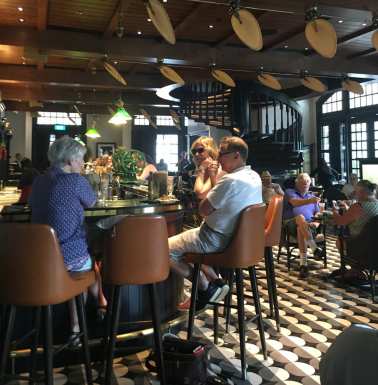
More Hotel Cocktails – Marina Bay Sands
The Marina Bay Sands Resort dates from 2010 and is just as emblematic of Singapore as is the Raffles Hotel. I think the shape of the hotel and the appearance of its 57th floor infinity pool are recognizable even by people who might not know the location. The hotel resort is part of the Urban Redevelopment Authority’s long-term plan for development around the Marina Bay basin, so here’s where to find skyscrapers and innovative, ecologically advanced designs. But we were there to have a cocktail, glimpse the famous infinity pool (only guests can swim) and get a bird’s eye view of the city. We began with cocktails in the lounge whose large windows are warmed by a lot of wood, then progressed to the terrace dominated by transparent Plexi barriers and open air. Exhilarating.

The Marina Bay Sands Resort.
A Short Cruise on a Short River – River Otters and Bumboats with Cute Eyes
There are Singapore River cruises and ocean sailing opportunities for every taste, including light shows and dancing fountains, but that wasn’t the mood, and we opted for an afternoon trip on a bumboat from Clarke Quay. This is not the Danube – you don’t cover much territory. But there are lovely historic buildings along the river, the high rise financial and commercial development around Marina Bay, and the famous resort, of course. All of that notwithstanding, two things stand out: river otters and bumboats’ eyes.
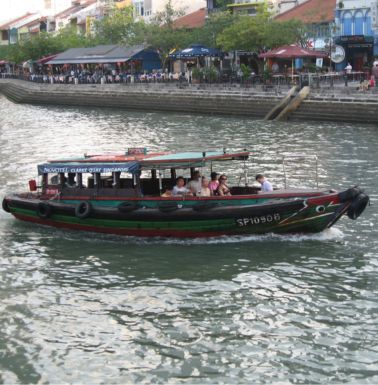
The Bumboats of Singapore.
I didn’t know about Singapore’s otters, and suddenly there was a group frolicking alongside our bumboat. Charming, I thought, and it can be nice to see wildlife adapting to urban settings. It seems that Singapore’s smooth-coated otter population has more than doubled since 2019 however, and they fish and hunt in the river and waterways, plus enjoy snacks from private koi ponds, too. They’re cute but the Park Board has had to issue guidelines on how to handle human-otter interactions. Number one rule: observe from a distance, as we did from our boat.
Then there were those eyes! According to the National Library Board of Singapore, bumboats (twakow or tongkang) were used in the Malay Archipelago for loading and unloading goods or for transporting cargoes, supplies and goods from ship to shore and vice versa. Think European lighters. The bow is often painted with “eyes” to enable them, metaphorically, to see danger ahead. It’s not uncommon in other cultures, either, but I never knew. On some of the touring bumboats, the eyes blink – it was the blinking that caught my attention. So, if you cruise on a bumboat, look deeply into its eyes as you board.
Here’s a good place to mention the Merlion. This enormous 70-ton, bright white statue and fountain at Marina Bay is the mascot of Singapore, the Lion City. It’s the representation of a lion with the body of a fish, mermaid-style. It’s a “must-see” and you will inevitably see it at Marina Bay (and who doesn’t go there). It didn’t excite me as a sculpture but there’s lots of associated symbolism, so good, I’ve seen and photographed it.
Below are a few more places we visited. For more about our 2024 day-to-day in Singapore, see Singapore Impressions – Tiong Bahru and its Hawker Culture.
Gardens by the Bay
At last! This deserves more space but here we go. According to Tripadvisor Travellers’ Choice Awards 2024, Gardens by the Bay is the “8th Best Attraction in the World.” I can’t possibly describe it fully here – visit the Gardens by the Bay website. But for a start, it’s principally a vast horticultural showcase for plants of the world. There are also educational exhibits, programs, and family events that can make it worthwhile to buy passes. (We didn’t.) Here’s where to see the iconic Supertrees, giant vertical gardens with nocturnal sound and light displays, all powered by green energy. Plants of the world are displayed in themed gardens and in vast, architecturally dramatic greenhouses. In January 2024, a winter holiday exhibit was just closing in one venue, and as current and former Minnesotans, we were charmed by the Nordic theme, with Falu red cottages covered in fake snow, evergreens, and adorable if stereotypical Vikings with long, blonde beards and horned helmets.
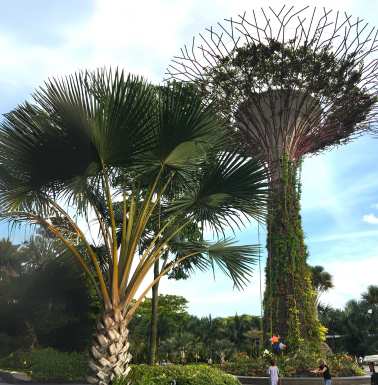
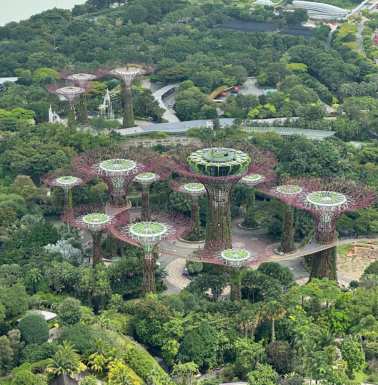
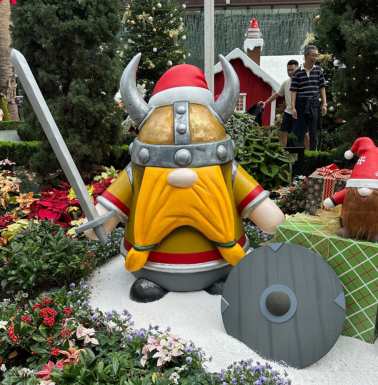
Changi Airport
If you do a search on “the world’s top airports,” or “the world’s best airport,” Changi is always near the top. It’s well known as an airport of course, but also simply as a destination, with its shopping, restaurants, museums, fun parks and aerial walkways. Just know that some of the good stuff requires paying for admission tickets. Many people will recognize the world’s tallest indoor waterfall, the Rain Vortex, in its forest setting. If you have a flight to catch in the wee hours, there are both sleeping rooms and an actual hotel at Changi – the sleeping rooms are great if you just want a nap. But we booked into the hotel, which gave us time to roam around Changi during the afternoon. And with a room, I at least got a hot shower and a rest before my midnight flight, and lucky Kathy got to spend the night.
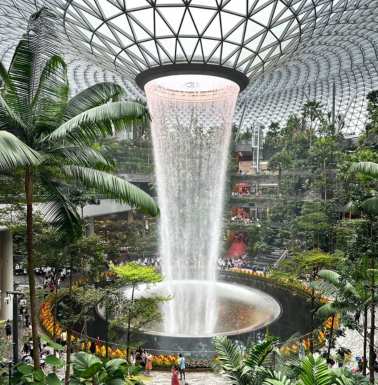
The Rain Vortex is the tallest indoor waterfall in the world.
Peranakan Museum
It isn’t easy to say what exactly being Peranakan means. It is a significant culture more than an ethnicity, a fusion of Chinese diaspora and Malay cultures. For more accuracy, I suggest reading articles, such as a 2021 National Geographic article, “In Asia, a gilded history lies hidden in plain sight.” And visit the Peranakan Museum for insights into this vibrant culture. The excellent museum is also in a heritage building.
Orchard Road
This is THE shopping street with big stores, shining malls, and all the international brands. It was crowded, and with so many familiar global brands, not the new experience that I anticipated. But it certainly conveys its glamor, and if you want major shopping in luminous stores, here it is. The street is worth visiting to see why Orchard Road is always on lists of top Singapore sights. This is also where to find Emerald Hill with its Peranakan heritage houses, a Singapore tourism office location, and a big bookstore.
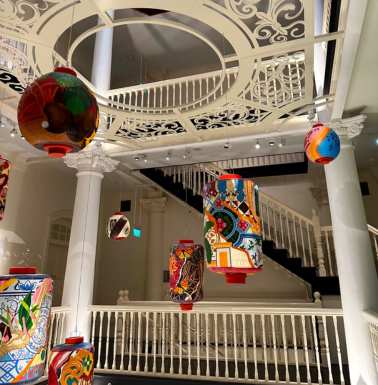
Inside the Peranakan Museum.
Bird Paradise
Think again if you’re not into birds – this is Asia’s biggest bird park, and it encompasses a mind-boggling area of distinct habitats with nets so high, extensive, and nearly invisible that birds exist in natural environments within the Mandai Wildlife Preserve. There are presentations, events and activities like feeding sessions for some of the birds (reservation and fee required) including the cassowaries which I always wanted to see in the wild. But now I’ve been close up and personal with these fabulous birds so I can move on. Easy to reach by public transportation, educational, fun, colorful; and a nice day out in nature.
Armenian Church and St. Andrews Cathedral
For some historic ecclesiastical architecture, visit the Armenian Church of St. Gregory and St. Andrews Anglican Cathedral. The Armenian Apostolic Church of St. Gregory the Illuminator was built in 1835, the first Christian church built in Singapore, one of the masterpieces of Irish architect George D. Coleman. There’s a lovely garden and interesting parsonage. St. Andrews is 19th century neo-Gothic and has been refreshed inside with white and a kind of Wedgewood blue. It’s a pretty building right in the center of the government quarter.
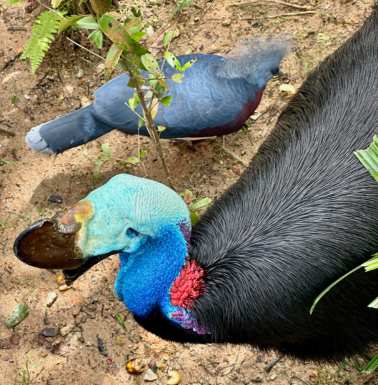
A Southern Cassowary and a Crowned Pigeon.
Red Dot Design Museum
The Red Dot Award for design concept is an international competition celebrating innovation and recognizing design excellence. In addition to a location within the headquarters city of Essen, Germany, the Red Dot Museum has also had a location in Singapore since 2005. The museum is installed in a geometrical, all-glass building where hundreds of award-winning designs are displayed on two floors. If you’re interested in design this is a good visit. There’s also a shop where every gift is a great design, and a small snack bar for a drink and a nosh. We went on a rainy day, and along with some of the designs that had become household items, I remember the grayness outside, the reflection of lights in the glass walls, and the Marina Bay Sands from a completely different angle.
For a closer look at one classic Singapore neighborhood, see Singapore Impressions – Tiong Bahru and its Hawker Culture.
Citations
- Biblioasia (a Singapore government agency): Give Me Shelter
- An aside: The Biblioasia site is a treasure trove of fascinating articles and podcasts where you could spend hours.
National Geographic: A Gilded History Lies Hidden in Plain Sight
